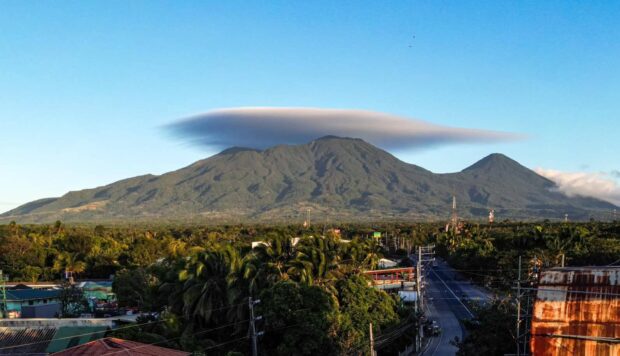
LENTEN DESTINATION Mt. Banahaw straddling the provinces of Quezon and Laguna, shown in this Feb. 18 photo, is among the favorite destinations of pilgrims and mountain climbers,
especially during the Holy Week. Despite the mountain being off-limits to the public, authorities have received reports that climbers, including pilgrims, wildlife hunters and orchid gatherers, are
able to reach its interior sections with the help of paid guides. —DANNY ORDOÑEZ/CONTRIBUTOR
LUCENA CITY—Despite the ban imposed by the government, pilgrims and hikers, for a fee, have managed to reach restricted sections of Mt. Banahaw in Quezon province, especially as the Lenten season started this month, reports gathered by the Inquirer showed.
A veteran mountaineer, who asked not to be named in this report due to security concerns, said those eager to climb Banahaw were willing to pay between P1,500 and P3,500 each to some residents of mountain villages to guide them through their climb via old foot trails leading to the summit.
“There are lots of them, particularly pilgrims, who are willing to pay just to reach their favorite spots in the mountain. The rate is expected to go up in the Holy Week,” said the source.
Magtanggol Barrion, a Department of Environment and Natural Resources (DENR) forest ranger in Mt. Banahaw and adjacent Mt. San Cristobal, admitted that they also received information on the illegal entry of trekkers.
Inspection
“We recently received information from local officials that groups are passing through a barangay here in Dolores [town] that was not previously taken by illegal climbers to the peak of Banahaw,” Barrion said in an online interview on Tuesday.
He said they were verifying the information and would immediately conduct an inspection of the route to stop intruders.
Mt. Banahaw straddles the towns of Lucban, Tayabas, Sariaya, Candelaria and Dolores in Quezon; and parts of the towns of Rizal, Nagcarlan, Liliw and Majayjay and San Pablo City in Laguna province.
Wildlife hunting
Archie Malabanan, secretary general of Ugnayan ng mga Mamumundok ng Banahaw (Association of Banahaw Mountaineers), also confirmed the information on the entry of pilgrims and hikers.
“Most of the guides are locals. And they are earning big,” Malabanan said in a separate interview.
Citing information from the Southern Luzon State University in Lucban town, Jay Lim, project officer of the public interest law firm Tanggol Kalikasan (TK), said there were also signs of illegal hunting of wildlife, particularly wild boar, in Banahaw.
“Numerous traps scattered in Banahaw were discovered lately,” he told the Inquirer.
According to Lim, TK has also been receiving information that wildflowers from Banahaw are now the primary targets of collectors venturing into the mountain.
“Since ready buyers are willing to pay, there are surely illegal flower gatherers because of the big payout waiting for them,” he said.
Lim urged authorities to enforce all rules and regulations to protect and preserve the natural healing process of Banahaw and San Cristobal.
“Banahaw has been doing its natural healing, we should also do our own [effort] to protect her,” Lim stressed.
Off-limits
In 2004, the Department of Environment and Natural Resources sealed off the interior sections of Banahaw and declared the peak off-limits to the public to rehabilitate the mountain after years of abuse by pilgrims and trekkers.
Before its closure almost 20 years ago, Banahaw had been receiving more than half a million visitors every Holy Week. People, however, were leaving behind tons of trash and damaging the mountain’s natural environment during their stay.
In 2009, Congress passed Republic Act (RA) No. 9847, declaring Banahaw and nearby San Cristobal a protected landscape in Quezon and Laguna.
‘Multiple use zone’
Since the closure, wildlife species, including the rare Rafflesia, considered the world’s biggest flower, began to reappear on the hills and gullies. Several species of animals, such as wild boars, monkeys and wildcats (musang), have also returned and have been reported roaming near the mountaintop.
Last week, Barrion reminded the public that Banahaw and San Cristobal remained off limits and that intruders would face punishment for violations of RA 9847.
He said there were no new regulations from the Protected Area Management Board (PAMB), a multisectoral body tasked by the government to monitor the two mountains.
The PAMB, however, has designated the mountain villages of Kinabuhayan and Santa Lucia in Dolores town as a “multiple use zone,” where camping, praying and other religious activities are allowed in certain areas.

